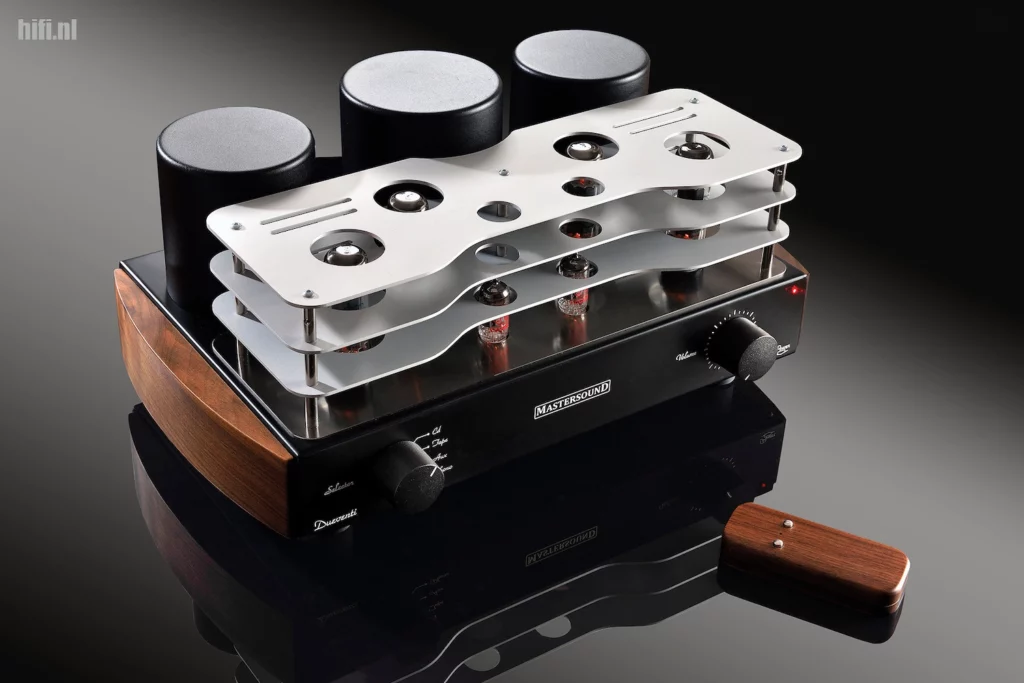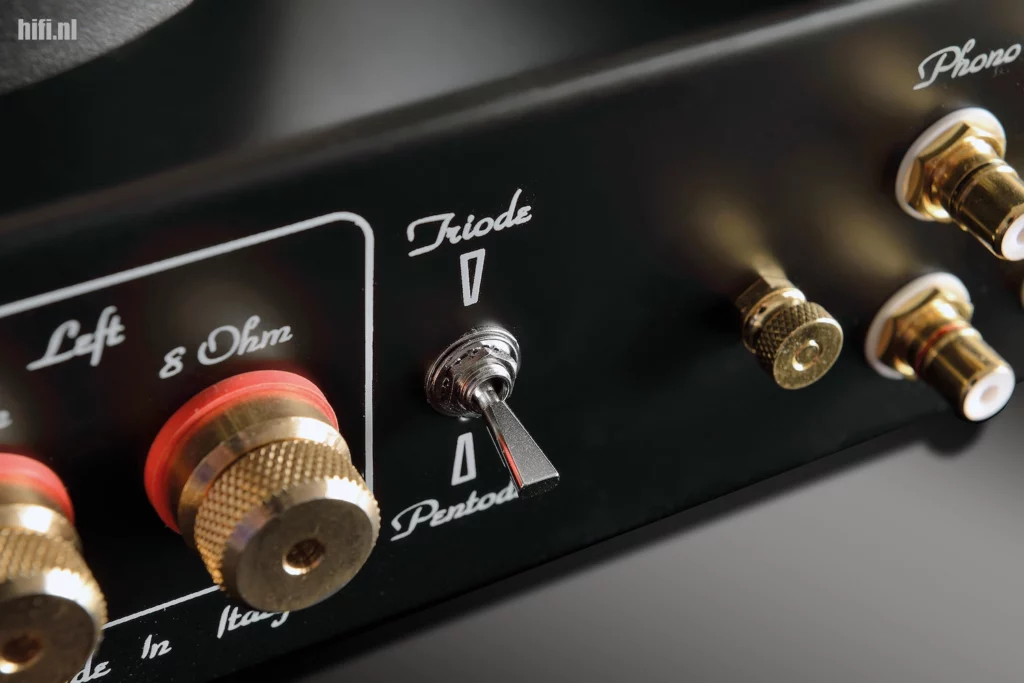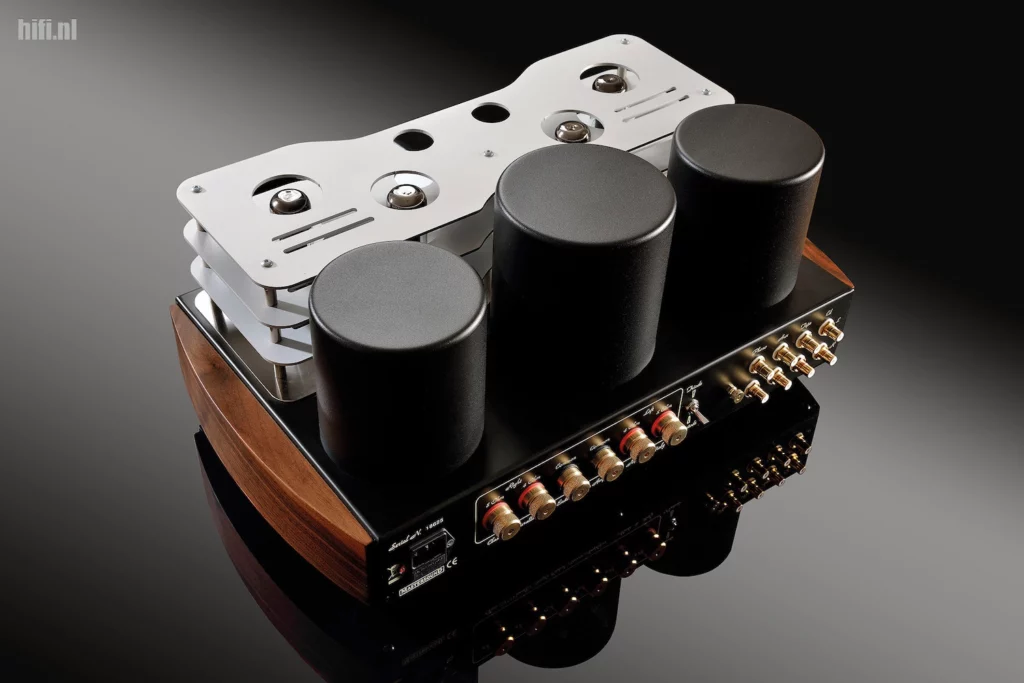Mastersound Dueventi HiFi.nl Review
REVIEW: MASTERSOUND DUEVENTI INTEGRATED SINGLE ENDED TUBE AMPLIFIER
WERNER ERO | JUNE 26, 2019 | PHOTOGRAPHY WERNER ERO | MASTERSOUND

Fortunately, there are still the so-called traditionalists. Designers and companies that honor proven techniques and use them to make beautiful contemporary products with smart adjustments. Read and enjoy in that context about the beautiful Italian Mastersound Dueventi integrated tube amplifier. A product with a modern touch in which craftsmanship, craft and, above all, profound enjoyment predominate and can thus bring a much-needed oasis of calm within our hectic existence.
master sound
The story of Mastersound reads almost like a suspense novel and takes off in the late 1950s when Cesare Sanavio graduates as an electronic expert with a thesis on output transformers in valve amplifiers. His first major project involves designing and building radio and television equipment for various foreign locations based on tube amplifiers. Because his family has also traveled with him because of his years of residence, his son Luciano also gains first experiences with building tube amplifiers. After returning to Italy, Cesare worked for several years as a consultant for various hi-fi companies, before he decided to set up Mastersound together with his two sons.
The very first Mastersound model is the 2-11 A integrated amplifier. A model that is so well received by the public and the press that it quickly becomes a benchmark within its price segment. After Cesare’s retirement, his sons Lorenzo and Luciano will continue the business until the end of 2015, after which the brand’s arrows will become much more internationally oriented thanks to the recruitment of new business partners. Fortunately, the company motto to develop the best possible tube amplifier within every price range, while maintaining the Italian tradition of pure handicraft and craftsmanship, remains completely unchanged.
Dueventi
Readers who have been following my stories for years will probably remember that until three years ago I played with a beautiful Italian Unison Research Performance single ended tube amplifier with great pride and great musical satisfaction. This Performance was not only an example of extreme musical involvement, but also breathed from its materials the much coveted Italian roots. Although the Mastersound Dueventi is basically sleeker and more business-like, the lines and choice of materials are also immediately recognizable as a pure Italian design. Along with all of their other world-renowned industrial designs, this Mediterranean country continues to be at the forefront of what I call ’emotional design’. Because whether it is modern or more classic, everything is right down to the last detail and exudes an unprecedented experience. The strikingly clean, deep black Dueventi is another visual statement that, in addition to a beautiful symmetry, plays the difficult to describe almost magical game of ideal proportions, delicately coordinated materials and elegant calligraphy fonts.

The front of the amplifier, built entirely of anti-magnetic steel, is graced by two rotary controls, the leftmost of which switches the three line inputs and a built-in phono MM preamplifier, while the right knob operates a motor-driven and thus remote-controlled ALPS volume control. The on/off switch is hidden at the bottom right of the front for maximum tidy appearance. In terms of tube layout, the amplifier is on the top side except for a stainless steel heat shield, adorned with four EL34 power tubes and two ECC802 (12au7) front tubes. An occupation that, due to its inefficient single ended operation, delivers a power of only 2 x 20 Watts connected in pentode, not to mention the apparently very meager 2 x 10 Watts in triode.
Manually adjusting the tubes is not included with this amplifier, because both the front and power tubes are fully autobias. Partly due to the output transformers developed entirely in-house, the bandwidth runs from 15 Hz to 30 kHz at 0 dB and any form of negative feedback can even be completely dispensed with. Despite the fact that the Dueventi with its 49 cm width (partly caused by the curved solid walnut side cheeks), 29.5 cm depth and 20 cm Although the height does not really look huge, the weight of 24 kg tube amplifier is typical due to, among other things, the large and heavy power and output transformers. The gracefully formed aluminum parts that protect the tubes from direct contact look nice and well-matched, while the clean layout of the rear shows specially manufactured speaker terminals with separate 8 and 4 Ohm output transformer taps and connections. To the right are the nicely spaced RCA connectors that offer space for even the most robust connectors, an earth connection for the record player and a tilt switch to choose triode or pentode operation. Finally, the package is completed with a Euronet plugconnection, and an extremely responsive solid walnut radio remote control for volume level only.
Single ended or push pull
It’s already mentioned in the headline of this article; single ended tube amplifier. But what does this actually mean and what is the difference with a push-pull design? Single ended is the mother circuit of all tube amplifiers and means that per power amplifier stage only one power tube is used for the amplification and is therefore always active in class A. With the more efficient push-pull circuit that always works in class A/B, you need at least two power amplifier tubes per channel. One for one half of the music signal and one for the other half. With a single ended circuit, the complete music signal does not have to be split, which in theory can result in a more pure reproduction.

Also because, due to simplicity, a whole lot of electrical components can be omitted that influence the music signal in a certain way at all times. Although there are also output transformerless designs (the so-called OTL designs), a transformer must always be used for, among other things, the impedance matching and voltage/current conversion. The disadvantage of single ended is that a constant quiescent current flows in one direction through the output transformer. As a result, the output transformer must be larger than with a push-pull design and an air gap must be provided in it to prevent saturation and magnetization of the transformer core.
Listen
A lot of words for a small, almost handy tube amplifier that really only has one task and that is to take the listener on a musical journey in which the technology is subordinate to the music. Through frequent sleepovers of a whole series of tube amps over the past fifteen years, I have gained a lot of useful experience with this principle. The moment I first ‘release’ the Dueventi in pentode to my ‘tube-friendly’ reference Master CC speakers, I immediately hear a well-known and highly valued tube amplifier feature. It is the signature that the meager 20 Watt output power on paper sounds much more powerful and above all more lively in practice. Where with many even large transistor amplifiers you have the feeling that music does not play freely and effortlessly and the power seems smaller than it really is, this Dueventi appears to react exactly the other way around. Because as if it were no effort at all, all musicians and singers are reproduced remarkably grandly, powerfully and with an impressive span of tension.
Of course you now think that this will probably be at the expense of a tight and crisp layer. But nothing is less true. Because the bass of this little Benjamin really convinces. While it doesn’t quite reach the low-end quality of the best transistor designs, it’s pretty fast, well defined (especially in pentode mode) and certainly not woolly or slow. Now this also has to do with the use of EL34 power tubes. Because if there is one that is also very affordable and readily available power tube that manages to combine aspects such as infectious spontaneity, musicality and neutrality within a single design, it is the EL34. What I really like in daily use is the operation of the radio remote control. Although you should not keep the two push buttons pressed for too long because the volume will then go up or down very quickly, the operation is very pleasant in daily practice. Especially because you never have to point the easy-to-handle gem at the amplifier.
Equations
When I compare the Dueventi with some other integrated EL34 amplifiers of the same wattage and price, such as a Unison Research S6 or PrimaLuna DiaLogue Premium, the Mastersound initially creates a somewhat smaller and more compact stereo image with a less flamboyant openness than the aforementioned two. But if you listen longer, the Dueventi turns out to be a very satisfying golden mean. A presentation that strives for a beautiful tonal balance, neutrality and pointedness, but is just as strong in aspects such as ease, expression, fluidity and dynamic contrasts.
Yet in the end it is mainly the musical stimulus that makes you want to listen to music endlessly, which is one of the strong selling points of this beautiful little amplifier. This is immediately noticeable in the fact that the Dueventi also manages to attract my attention at a soft level. With some amplifiers, music passes you mindlessly. You play an album or tracklist and afterwards you don’t even know which songs have passed by. But not with this Mastersound that really involves you in the musical event and makes you aware of the expressiveness and musical message of the artists.

Musical examples
A truly wonderful example of these last two qualities is Haevn’s debut album ‘Eyes Closed’. The first time I heard this music, it was as if I had returned to the ‘golden age’ of audio. Nothing no loudness war or the ‘modern’ combination of horrifying blurring and emotionlessness, but above all breathtakingly beautiful songs that, in addition to being tonally rich, also possess the atmosphere, tranquility and layering that can characterize Scandinavian music. But nothing turns out to be less true when Haevn turns out to consist of the Dutch duo of film composer Jorrit Kleijnen and singer-songwriter Marijn van der Meer, linked for a commercial. Volvo was followed by an advertisement for BMW, after which this atmospheric music quickly stormed the international charts of Shazam. The success was so great that it was decided to develop the original 30 second compositions into full songs produced by phenomenon Tim Bran. Not coincidentally also the producer behind the British trip hop band London Grammar and Birdy. The addition of guitarist Tom Veugen, drummer David Broeders and bassist Mart Jeninga eventually resulted in the very successful band Haevn. That this music is also called dream rock is immediately clear with the first calm and extended song The sea. The stereo image can take very wide forms and the Dueventi does drop some small stitches as expected. But the deep and very powerful registered low end is nice and tight, well defined and more importantly, it carries the number impressively.
The following Bright lights is more up-tempo and so beautifully composed that it could even become a future classic, while the melancholic Finding out more has served as the basis for the aforementioned BMW commercial. Very clever that this third smallest Mastersound amplifier leaves so many of the facets of this secretly very demanding music intact. Deep, powerful and defined low, the sonorous singing voice of lyricist Marijn that shines like a clear beacon over his own music and a high range which is a well-proportioned part of the whole. Always informative, fluid and sophisticated and thankfully never dry or intrusive.
PRaT
Although the term Pace Rhythm and Timing (PRaT) is mainly known to audiophiles, it is loosely translated for audio products that are able to leave the complex rhythm and timing structures of a piece of music intact as much as possible. Especially for designers, this is quite a difficult task because you can’t measure it, but you can hear it. A very good example of this is the album ‘Introducing…’ by the Cuban pianist Rubén Gonzalez who only became famous at a later age and who died in 2003. This music is played so infectiously ‘grooving’ and is registered so tangibly that with a good system, which doesn’t have to cost the world at all, you simply can’t sit still anymore. Introducing… was recorded in 1996, exactly one year before the acclaimed Buena vista social club masterpiece by guitarist and producer Ry Cooder. A production in which Rubén also played. Already at the first songIn addition to an unprecedented passion and enthusiasm, La Engañadoro also immediately audible fantastic timing. It seems very simple at first hearing, but if you listen a little more closely, it is then assertively at the front of the measure, only to ‘lean back’ languidly in the back a little later. The Dueventi also appears to score high in this area. Because in addition to an excellent PRaT, the spatial properties and the view remain perfectly intact at the same time. This creates a beautifully breathable overall whole, which quickly pushes the hi-fi feeling to the rear and allows maximum enjoyment.
From Pentode to Triode
The last thing I try on this wonderfully uncomplicated amplifier is the pentode to triode or vice versa tilt switch on the rear. Unlike, for example, the PrimaLuna DiaLogue models where this function can be arbitrarily controlled during gameplay, the Dueventi requires the amplifier to be turned off before the other option can be turned on. You can also not switch it off, but then you will hear a loud bang over the speakers! A peak that is not exactly conducive to their lifespan for both the loudspeakers and the power tubes. What actually happens when switching is that the screen grid of the pentode EL-34 power tube is shorted to the anode, causing it to behave like a triode. In a technical sense, this results in more distortion and half the power, but musically, this option certainly makes sense. Because although the need for easily controllable loudspeakers with a higher efficiency is clearly more compelling and the reproduction perceptibly less dynamic, on the other hand, sophistication and coherence are increasing. Musicians play even better together, instruments sound even more like one layered whole and it’s just more tangible music.

In absolute terms, the layer control and absolute transparency in this triode mode are a bit less, but everything in between has more coherence in a way. It’s as if the glue to hold the entire musical panorama together has worked better and the musical intentions come across better. Finally, as far as the audiophile parameters are concerned, the Dueventi actually has only pluses and actually no real shortcomings. Yes, as mentioned, the stereo image is not exactly exuberant and also in terms of exuberant expression/openness, this amplifier is not the best performer. But if I look at the very carefully composed total package, then this is the amplifier that you will like the most because it actually has no shortcomings.
Conclusion
With the Dueventi, the Italian Mastersound has put down one hell of a product in a just affordable price range. The amplifier is very well built, very neatly finished and with its four ‘classic’ analog line inputs offers plenty of space for most situations. Digital is of course also possible, but then you must have a separate DAC or sources with a built-in converter. Despite the apparently meager 2 x 20 Watts, the amplifier turns out to be surprisingly good with most loudspeakers and can even be surprisingly loud! Of course you can’t throw a party with it, but with daily use you really won’t be short of anything. Incidentally, this changes when you switch from pentode to triode, because 2 x 10 Watt is so less that an efficiency of at least 90 dB or preferably even higher is necessary.
Mastersound Dueventi
€ 3.490
0 Comments